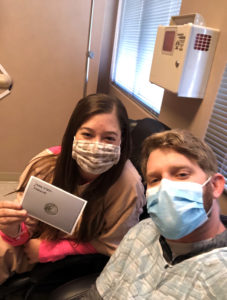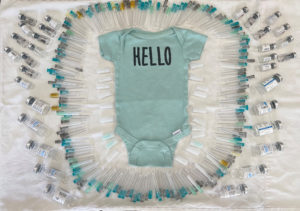One couple’s journey to conceive included a combination of male and female infertility
 Many couples who struggle to have a baby on their own eventually learn that they have a combination of male and female infertility. This is exactly what happened to Lindsay and Brandon on their journey to parenthood.
Many couples who struggle to have a baby on their own eventually learn that they have a combination of male and female infertility. This is exactly what happened to Lindsay and Brandon on their journey to parenthood.
When they got married, the couple already had plans to start a family. After seven months of trying without success, Lindsay felt like something was wrong, so she reached out to her OBGYN. Sadly, it was not a good experience.
“My OBGYN told me that it was all in my head and that I shouldn’t even reach out until I’ve been trying for a year. I was adamant though, so my doctor ordered testing for me and my husband,” Lindsay recalls. “It’s good I listened to my gut because all the tests came back with some abnormalities.”
Female fertility testing revealed that Lindsay had uterine polyps and a thyroid issue. Lindsay’s doctor prescribed thyroid medication and performed a hysteroscopy to remove the polyps. As for Brandon, a semen analysis showed that he had a low sperm count and low sperm motility (movement), so the couple visited a urologist.
They worked with the urologist for three months. However, taking the recommended medications and making lifestyle changes didn’t help the couple conceive. That’s when the urologist recommended that Lindsay and Brandon visit Texas Fertility Center.
Starting the journey to overcome male and female infertility
 When the couple requested an appointment, the front office scheduled them with Kaylen Silverberg MD. As soon as they met with this Austin infertility doctor, they knew they were on the right track.
When the couple requested an appointment, the front office scheduled them with Kaylen Silverberg MD. As soon as they met with this Austin infertility doctor, they knew they were on the right track.
“He’s a wonderful doctor, and we felt very lucky that he had an opening,” Lindsay says. “From the first appointment, he showed that he cared about us, so we never felt like a number.”
Lindsay asked Dr. Silverberg about intrauterine insemination (IUI). He told them that he was willing to try it. However, based on the couple’s male and female infertility diagnoses, he explained that in vitro fertilization (IVF) was likely to be the better option.
After taking about a month to consider Dr. Silverberg’s advice, Lindsay and Brandon decided to move forward. The first IVF cycle resulted in two healthy embryos, as revealed by preimplantation genetic testing (PGT).
The first embryo transfer didn’t take, so Dr. Silverberg performed two mock transfers to learn more about Lindsay’s implantation window. “It turned out that my uterus is only receptive for a very short time,” Lindsay explains. “I was very grateful that Dr. Silverberg did the mock transfers, especially since we only had one embryo left.”
After doing the second embryo transfer, Lindsay and Brandon learned they were pregnant. However, they experienced a heartbreaking miscarriage just a few weeks later.
“It was very hard, but Dr. Silverberg was there for me. He gave me his cell phone number and talked me through it when I called him after the miscarriage started,” Lindsay recalls. “I was scared, but he was compassionate and supportive. He told me that I had done nothing wrong and just went above and beyond to be there for me.”
Taking the next step to try again
 As the couple took time to grieve, the TFC team was supportive and respectful. “They were there for us when we needed them, but they never pushed us to start trying again. They said to call them when we felt ready,” Lindsay says.
As the couple took time to grieve, the TFC team was supportive and respectful. “They were there for us when we needed them, but they never pushed us to start trying again. They said to call them when we felt ready,” Lindsay says.
Once the couple was ready to try another IVF cycle, they reached out and got an appointment the same day. With this second cycle, the couple had one healthy embryo and one mosaic embryo.
After transferring the healthy embryo, Lindsay and Brandon learned they were expecting. Today, they are 20 weeks pregnant and feel so grateful to Dr. Silverberg and his team for their support.
“Texas Fertility Center is really like a family because the team there shares in your sorrows and your joy. For example, when we graduated to OBGYN care, all the nurses clapped for us as we left,” Lindsay says. “We found it was sad to leave, but thankfully, Dr. Silverberg recommended a great OBGYN so that I could transfer to a supportive doctor for the rest of my pregnancy.”
There’s power in getting information and sharing your story
Lindsay and Brandon wanted to share their story to help other couples who are facing male and female infertility.
“I’ve been very open about our story, but I know that it can be hard to talk about infertility and miscarriages,” Lindsay explains. “I want other people to know that they aren’t alone in this and that they can get through it to have a baby.”
She also has two pieces of advice for anyone who is experiencing infertility. The first is to seek out help if you feel like something is wrong.
“It can be overwhelming to see a fertility specialist, but for me, the unknown was scarier than finding out something I might not have wanted to hear. I figured that at least that information could help us take the next step.”
As for the second piece of advice, Lindsay stresses that it’s important not to forget about the male partner.
“I also think it’s important to advocate for the wellbeing of partners. So much of the focus is on the woman because she’s carrying the pregnancy, so the man can feel left out or guilty that he can’t help more,” she explains. “It’s helpful to be aware of how much infertility affects men.”














Comments are closed.